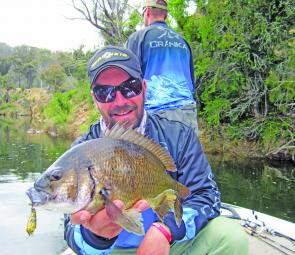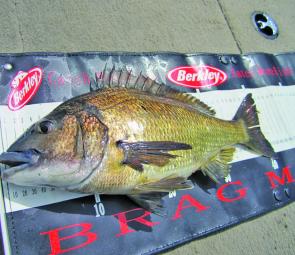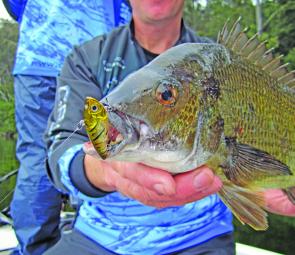Any trip to Tasmania for me is always easy to push to the top of the ‘to do’ list.
To say that I love to fish the Apple Isle would be short changing things a little, and I reckon anyone who has spent any time wetting a line in this great fishery knows what tree I am barking up.
After organising the schedule for a recent work trip to test some new lure models and colours, the decision was made to head to the east coast and fish the Scamander River for the last day of the trip. My good mates Steve Steer and Andrew Cox were dragged along for the ride, with not much arm twisting needed I must say!
After a couple of chilly, but productive trout sessions up on Great Lake the day before, we headed down the mountain at first light. Seventy dollars lighter, we left the roadhouse at Epping Forest loaded to the eyeballs with bacon and egg rolls, coffees, drinks, sandwiches and chocolate bars for the day ahead. Come to think of it, I think I may have also paid for old mate’s lunch standing next to me at the queue.
I have been fortunate enough to fish the Scamander on several occasions, including an eye-opening first trip to catch Tassie bream in 2005. On the preceding trips it has always provided an excellent warm up for the upcoming ABT event at nearby St Helens each February. The river boasts a variety of fishing options for bream, and can also turn up some handy by-catch like salmon, trevally and big mullet.
Current fishing reports from a variety of local fishos suggested that there was a pre-spawn migration in progress and that the bream were likely to be in big numbers along the rock walls upstream in the system. A recent dump of fresh water had dis-coloured the water slightly, but with Messrs Steer and Cox on board, I was confident their collective knowledge would find us a few bream on the day.
For once, Steersey managed not to fall in at the ramp, and we were away. And once we reached our chosen location upstream, it wasn’t long before the first bream was being bought to the net, in fact I think it was first cast! Quite a few bream had schooled up close to Hospital Corner, and were taking a liking to the new Cranka vibe colours we were throwing at them.
Coxies boat must have looked quite a sight from the bank, with three lunatics on board, two GoPro video cameras shooting away constantly, and enough fishing tackle to last a lifetime on the deck. The expectation was that the schooling bream would become more active as the sun got higher, so we pushed on further upstream to find the mother load.
Solid readings on the Side Imaging sounder opposite the mouth of Trout Creek soon provided some better quality fish, most of them around or over 1kg in size. The bream were holding very tight to the rocky structure, and casts needed to be put right into the mix to draw a strike.
The slower sink rate of the Cranka vibes we were using proved very effective in this technique as we could lob them right amongst the rocks and bounce them down the face to the waiting bream. Often the lure was plucked on the drop, or as it paused momentarily before a lift.
We also managed to snag a few bream from the fringe of this part of the system, and also from some of the other shallower entrances to the backwater lagoons and bays. Bream were also taking up station in the snags in smaller groups, but these fish seemed uninterested in feeding. That didn’t stop me throwing a thousand casts at them with a pink grub!
At the risk of banging on about how many bream were caught, we managed to boat nearly 70 bream over 6 hours between three anglers. The best five for the day would have been very competitive tournament bag indeed. We estimated this weight around 5.9-6.1kg! Fish of the day was 40.5cm to fork and probably weighed around 1.5kg. And speaking to a few more anglers that visited the river shortly before and after our trip, they experienced very similar fishing as well.
When you are lucky enough to experience a concentration of bream like we did on this day, a true appreciation of the health and vitality of the system is gained. And consequently the importance and value of bream as a recreational sports fish is realised. Catching bream on lures generally allows easy catch and release, and they are a durable fish that seem to co-operate for a few quick photos before you let them go. Personally, I get a big kick out of letting a bream swim free from my hands after capture, and I know I’m not the only one.
The quality of the bream fishing in the Scamander river is not confined to a migratory fish bite, like it was on this day. In fact during normal times of the year, the fishing is better in many ways. The main difference is that there can be a wide variety of sized fish that will grab your lures, particularly on the shallower flats. This makes for some very rewarding bream spinning, and also makes this system an excellent learning and practice arena for those trying to advance or fine tuning their breaming skills.
I have always found the topwater fishing in the Scamander both rewarding and very addictive. The flats, reed edges and backwater lagoons are great places to chuck a surface lure and search for a few bream. The reed edges in particular can be very effective for surface plastics, as it is often necessary to sink the lure back to the bream to draw a strike. Bream will also feed and ‘dig’ on the immediate sand edges nearby to the reeds on a rising tide and provide some very challenging sight fishing.
The upstream rock walls and snags are the prime areas for parallel presentations with various hardbodied lures and often produce some big bream.
Rock-dwelling bream during the summer months tend to pull a bit harder as well, so don’t be shy to tweak the drag up a few notches or so. Methodically fishing these areas with sinking stickbaits, vibes and plastics will produce plenty of fish as well.
The shallower bays and flats are probably the most overlooked areas of the system, and can produce some great bream fishing, but like all skinny water locations, the fish can be a little flighty. Try to ‘match the hatch’ as best as you can, especially the local baitfish and shrimp which are very prevalent over the summer months.
Growing up in Victoria, I was lucky to spend a fair bit of time in Tassie during my younger years, and have been very fortunate to have experienced some great fishing opportunities during recent times as well.
The bream fishing community is Tasmania is very strong and led by a dedicated website, run by Pat Sullivan. I reckon we’ve got comparable bream fishing in East Gippsland, but just like the trout fishing, there’s something very special indeed about bream fishing in Tassie.
Especially on the Scamander River.
Reads: 13134
Steve Steer equipped with the GoPro head camera shows the quality of the Scamander River bream, as well as the beauty of the surroundings.

Author Wayne Friebe with a typically fat example of Tasmanian black bream and the Cranka vibes used to catch them.

Twin fish, twin lures and twin anglers – matched!

With light leaders it takes finesse and team work to land hard fighting east coast Tasmanian bream.

On the lie detector – at around 40cm, this is a thumper anywhere in the country.

Andrew Cox with a fist full of black.

Cranka vibes were the lure of choice, and other hardbodied presentations work well also.




